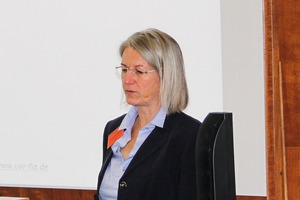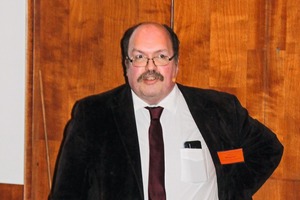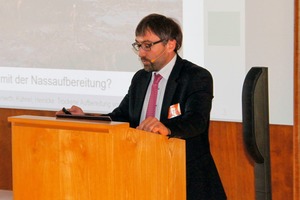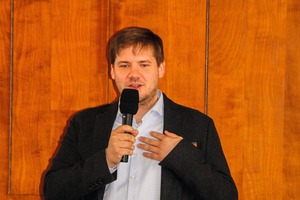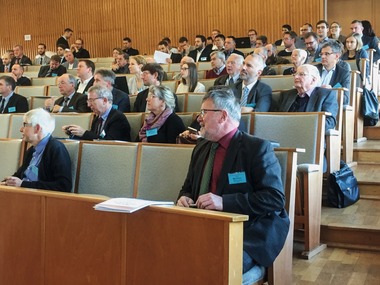Mineral Processing and Recycling –
7 and 8 November 2019 in Freiberg, Part 2
7 and 8 November 2019 in Freiberg, Part 2
Machines, equipment and sensors
For the preparation of representative samples, the paper presented by Dr Tanja Butt, Thomas Schmatz and Holger Neumann (Retsch GmbH) on “Processing slags/waste-derived fuels/WEEE as well as primary resources of all types” gave some important tips. With modern analysis methods, precision and accordingly detection limits are constantly improved so that even very small traces of sample constituents can be reliably detected. Sample preparation, however, which is upstream of the actual analysis and can influence this considerably, is often neglected. The components in a laboratory sample are often heterogeneously distributed. Only with grinding can the sample be homogenized, and an even distribution achieved. As only small quantities of the laboratory sample are needed for the actual analytics, standardized dividing methods like the use of ripple dividers or sample dividers is necessary.
“Challenges in electrostatic separation in the dispersity range <100 μm – status quo in the Leoben research activities” was the title of the paper presented by Sabrina Gehringer and Prof. Helmut Flachberger (Montanuniversität Leoben). With the exploitation of deposits with a lower content of useful components and, associated with this, increasingly fine intergrowth between valuable mineral phases and gangue rock, mineral processing in the dispersity range <100 μm is becoming increasingly important. At present, fine grain processing in wet operation dominates. On account of the limited availability of water and restrictive environmental regulations, dry-operated fine grain processing is gaining increasing importance. The latest development, which was realized as part of the dissertation project of the first-mentioned author, is a triboelectric charging unit based on a fluidized bed reactor. This machine offers the possibility for monitoring of the charging process in a clearly defined system in which influencing factors such as the temperature curve and the air volume flow can be recorded during charging. Moreover, in the fluidized bed reactor, the flow behaviour of the air can be influenced with the use of a range of different fluidized beds. In addition, in the fluidized bed reactor a possibility is integrated for the addition of reagents to chemically influence the charging of mineral phase surfaces. On the basis of systematic sorting tests with a triboelectric belt separator on laboratory scale, the sorting efficiency of a range of raw material samples was studied in detail. With triboelectrostatic belt separation of caustic calcined magnesite, for example, the content of the accessory mineral SiO2 in the concentrate could be lowered from a feed content of 2.8 % to 0.8 %. The MgO content in the concentrate was increased by 10 % up to 90 %. With the combination between belt separator and the upstream controlled charging in the fluidized bed reactor, sorting efficiency is to be further increased.
Dr Hagen Müller, Dr Jan Lampke (HAVER ENGINEERING GmbH), Klaus Fennenkötter and Markus Löher (HAVER NIAGARA GmbH) reported on “Ultrafine screening with ultrasonics – state of the art and examples from industrial practice”. The advantage of ultrasonic excitation screens for production, e.g. in powder metallurgy, colour pigments or even limestone, is the very low specific power requirement and in the use of quadratic mesh geometries even with steeply pitched screening surfaces. In these cases, more cost-intensive screening surfaces with oblong mesh are not necessary and the quality of screening is increased, too. In this paper, the state of the art in screens with ultrasonic excitation is presented and the efficiency of the technology presented with reference to examples from the industrial field.
With “DC – development of a deflector classifier”, Daniel-Christian Karhoff, Fabian Mertens and Marc Giersemehl (NEUMAN & ESSER Process Technology GmbH) gave insights in their company’s field of work. The overarching objective was to create a classifier with a classifier housing diameter up to 3000 mm for cut-points between 50 μm and 800 μm, which can be used downstream of grinding machines such as ball mills, roller mills, impact mills or offline. Depending on the size, the feed rate ranges between 0.5 t/h and 150 t/h at an air volume flow rate between 500 m³/h and 150 000 m³/h. The classifier drive powers vary between 0.5 kW and 100 kW. The principle of operation of the Deflector Classifier (DC) is that the feed material from an upstream grinding machine is conveyed pneumatically by the process gas (air) into the classifier housing and with the interposing of the deflector at the classifier wheel, the material is divided into a coarse and fine fraction. For good classifying results, both the radial and the tangential velocity components of the process gas must correspond to the required separation conditions at the outer circumference of the classifier wheel. The results of the laboratory tests show good agreement with the predicted performance. A DC on production scale with a classifier housing diameter of 3000 mm has been in operation for three years. Classified in this is limestone at a specific energy consumption of 0.93 kWh/t and a feed rate of 35.5 t/h.
For the “Dry processing of iron ores”, Prof. Holger Lieberwirth, Richard Kühnel (IAM) and Dr Felix Heinicke (Köppern Aufbereitungstechnik GmbH & Co. KG) studied the design of dry grinding and classifying circuits with high-compression roller mills for the beneficiation of ores. With the optimization of the wear behaviour of the comminution machines and classifiers, increasing application possibilities are opened up in raw materials processing, e.g. for comminution of solid rock such as copper and iron ore. In contrast to cement applications, ores, however, exhibit in many cases, besides differences in particle size, considerable differences in density between the valuable minerals and tailings, which have an effect on the separation process. The degree of intergrowth between the particles also has a significant effect on the separation performance. These effects have been researched as part of collaborative studies by the company Köppern and Freiberg University of Mining and Technology for industrial applications.
In the paper “CEOPS – added value with continuous particle size measurement” Markus Dietachmayr and Rupert Kirchner (CEMTEC Cement and Mining Technology GmbH)presented the measurement system. In 2012, CEMTEC put its first CEOPS (Cemtec Online Particle Size) analyser into operation. At present, no fewer than 15 CEOPS systems are in operation, both in wet and dry grinding plants on four different continents. The system enables the measurement of suspensions and powders with a maximum particle size up to 2 mm and allows measurement at up to four sampling points per unit. The CEOPS measurement system has so far been adapted for ball mills, vertical mills, but also agitated mill circuits. Thanks to the real-time measurement of the particle size distribution of the ground product, the quality of the ground product could be improved, and energy saved. In the case of dry-grinding machines, energy savings of 1.5 % per tonne produced material resulted. In the case of wet plants, the reagent consumption in a downstream flotation plant could be reduced.
The “Selection of an optimum sensor for sensor-based sorting with application of automated mineralogy in combination with machine learning” was addressed by Dr Marius Kern, Laura Tus¸a, Mahdi Khodadazadeh, Prof. Karl Gerald van den Boogaart, Richard Gloaguen, Prof. Jens Gutzmer (HIF) and Thomas Leissner (MVT). With the innovative simulation-based approach presented, it is possible to select a sensor on the basis of quantitative mineralogical and textural data, which with the available automated mineralogy methods can be collected quickly and at low cost (see also “Rethinking ore sorting”, AT 03/2020, pp 54-64). As a case study, data from more than 100 thin sections of two different ore types from the Sn-In-Zn deposit at Hämmerlein, Erzgebirge, were used. Parameters such as mineral grain size distribution, modal mineralogy, mineral area and mineral density distribution were used to simulate the prospects of success of sensor-assisted sorting with various sensors. The results showed that the frequency of rock-forming chlorite and/or density anomalies can be used as a proxy for the frequency of cassiterite, the main ore mineral. This indicates that sorting of the Hämmerlein ore can be achieved either with a short-wave infrared detector for quantification of the chlorite content or a dual-energy X-ray transmission detector for estimation of the cassiterite content. The estimation of the cassiterite content of a sample was optimized by means of “machine learning” with the data of the short-wave infrared detector being integrated with the mineralogical data. This leads to a further important improvement of the simulated results. The developed approach can be adapted to other raw material types and has great potential to become a key technology for the optimization of mineral processing.
Dr Stefan Jäckel, Raphael Sperberg (Gebrüder Jehmlich GmbH) and Oliver Schindler (Freiberg University of Mining and Technology) spoke on the “Processing of plastics and organic resources with the newly developed JEHMLICH CM 342 cutting mill”. The cutting mill developed within the framework of the project “BioMatUse – studies on the production and use of new, high-grade and sustainably biobased products from waste and residue of sugar and rice production” is able to comminute these materials in a defined way. The CM 342 cutting mill works according to the principle of parallel cutting with three rotor and stator blades in each case. It is possible to feed the products to be ground in aggregate material or as a column. A frequency converter is used to vary the speed of the mill between 600 min-1 and 1800 min-1. The structure of the cutting mill is pressure-shock-resistant to 0.5 bar so that the mill with appropriate relief valves is also suitable for grinding dust-explosive materials. Screen width and speed are besides the structural design the main operating parameters to influence the particle size of the ground product. As test material both organic raw materials (wood chips) and plastic composites (preshredded rubber shoe soles) were used. Smaller screen width and increasing speed effect a decrease in the particle size of the ground products. An outlook was given on existing and potential applications of the cutting mill.
In the paper “Use of air separation tables for density sorting of mixed materials” presented by Dr Mathias Trojosky and Andre Pascal Kindler (ALLGAIER Process Technology GmbH), a new separating table of the type GSort for density separation of particle aggregates was presented, which is particularly suitable for sorting of large solids streams in the minerals and recycling industry. Systematic changes to the GOSAG separating table, which has been tried and tested in-house for many years, and its influence on the separating process were presented, and the results of laboratory and field tests for optimization of the technology as well as typical applications from the industrial field were described. The influence of the “new” process parameters was studied for different material mixes with different particle size. The GSort can be used to sort especially heavy products, like ores and slags, efficiently on an air separation table based on the characteristic particle density. Advantages of the new separation table compared with previously available machines are the adjustability of the deck, the easy setting of the table stroke frequency and the possibility to change the upstream flow deck quickly and easily.
“Extinguishing before burning starts – operating principle and applications of spark extinguishing systems” was the subject of the paper presented by Denis Sauerwald (Fagus-GreCon Greten GmbH & Co. KG). A fire or a dust explosion always occurs when in the same place, at the same time three conditions are met: combustible dust, air (oxygen) and an effective source of ignition. At risk are especially plants for comminution, drying and pressing with their pneumatic or mechanical transport routes and extraction systems, but also equipment for separation or storage such as filters, cyclones, silos and bunkers. With a spark extinguishing system, it is possible to detect initial ignition sources and to eliminate these directly before a fire or dust explosion is triggered.
Poster exhibition and company presentations
On the first day of the event, all poster exhibitors were able to introduce their presentations in short talks. In the afternoon, there was opportunity for discussion at the posters.
The HiF was represented with two posters:
Christian Hintersatz, Dr Sabine Kutschke and Dr Katrin Pollmann addressed “Biohydrometallurgical processing of low-metal flotation residues”.
Dr Martin Rudolph, Stefan Dirlich and Kerstin Eckert presented “The EU project FineFuture – a research and innovation project on the flotation of fine particles”.
Das MVT Freiberg was represented with four posters:
Robert, Kratzsch, Dr Thomas Mütze, Prof. Urs A. Peuker presented “Approaches for mechanical recycling in additive manufacturing”.
Lieven Schützenmeister, Dr Thomas Mütze and Jan Strotmann1, Thomas Lappe1, Guido Kache1 (1 thyssenkrupp Industrial Solutions AG) reported “On the influence of the feed size and roller speed in cement grinding in a pilot plant scale high-compression roller mill”.
In the poster displayed by Denis Werner, Dr Thomas Mütze, Prof. Urs A. Peuker, the “Influence of the depth of disassembly on the comminution and drying of lithium-ion batteries” was presented.
Tony Lyon, Dr Thomas Mütze, Prof. Urs A. Peuker presented a poster on “Stripping electrode films from lithium-ion batteries”.
Other poster presentations addressed the following topics:
Dr Esther Gabor, Richard Frenkler, Jan Freytag, Niklas Brenner and Marc Gauert (BRAIN Aktiengesellschaft, Zwingenberg, Germany) reported on “Wet mechanical-biological recovery of valuable metals from fine-grained secondary resources”.
“Testing a new collector for cassiterite flotation” was the topic of the poster displayed by Irina Bremerstein (UVR-FIA GmbH) and Dr C. Rudolph (Zschimmer & Schwarz).
Dr Maria Schäfer, Prof. Schoenherr (Hochschule Zittau/Görlitz) und Steffen Exler (Kluge GmbH Königswartha) presented the “Development of processing technology for chaff-straw”.
Carolina Carvajal Gutierrez and Prof. Holger Lieberwirth (IAM Freiberg) displayed the poster “A microscopic insight into the manganese recycling economy”.
Three companies were represented with company presentations:
“Mitteldeutsche Umwelt- und Entsorgung GmbH – MUEG” Braunsbedra is a company operating in waste management, environment and mine restoration, landfilling of mineral waste, recycling of power plant waste, recycling of mineral and commercial waste.
Neuman & Esser Process Technology GmbH is an internationally leading manufacturer in the fields of compressor technologies as well as grinding and classifying systems.
ZOZ GmbH based in Wenden presented besides processing equipment (Simoloyer®) for mechanical alloying, high-energy and reactive grinding (HKP), equipment for grinding and comminution, stirring and dispersion, screening and filtering as well as for atomization, degassing and passivation.
Closing words and announcement of the Annual Conference 2020
The closing words were given by Dipl.-Ing. Silke Thümmler, Chairperson of the “Gesellschaft für Verfahrenstechnik UVR-FIA e.V. Freiberg”. Together with the “Helmholtz Institute Freiberg for Resource Technology” and “Freiberg University of Mining and Technology” as well as the employees of UVR-FIA GmbH Freiberg, a conference had been arranged that all attendees enjoyed. Thanks are also due to the moderators for the individual complexes in the programme of papers Dr Morgenroth and Dr Kamptner (UVR-FIA Freiberg), Dr Rudolph (Helmholtz Institute Freiberg), Prof. Lieberwirth and Dr Mütze (Freiberg University of Mining and Technology) as well as Prof. Schönherr (Hochschule Zittau/Görlitz).
The evening function was arranged on the first day of the conference, again in the Schankhaus 1863 of the Ratskeller in Freiberg, and provided the opportunity for sharing ideas and continuing discussions in a relaxed atmosphere. On the second day of the conference, the attendees were able to view the facilities of UVR-FIA GmbH Freiberg with the Managing Director Dr Morgenroth as well as those of the Helmholtz-Institute for Resource Technology in Freiberg with Dr Rudolph, head of the Mineral Processing department.
The next “Mineral Processing and Recycling” conference will take place on 12 and 13 November 2020 at the same venue in the auditorium of the HIF/HZDR (former FIA building) in Freiberg. Abstracts for papers, posters and company presentations should be submitted to the Conference Organization UVR-FIA GmbH at the internet address www.uvr-fia.de or by e-mail to: tagung@uvr-fia.de. Abstracts of the conference papers are also available at the above-mentioned internet address.






